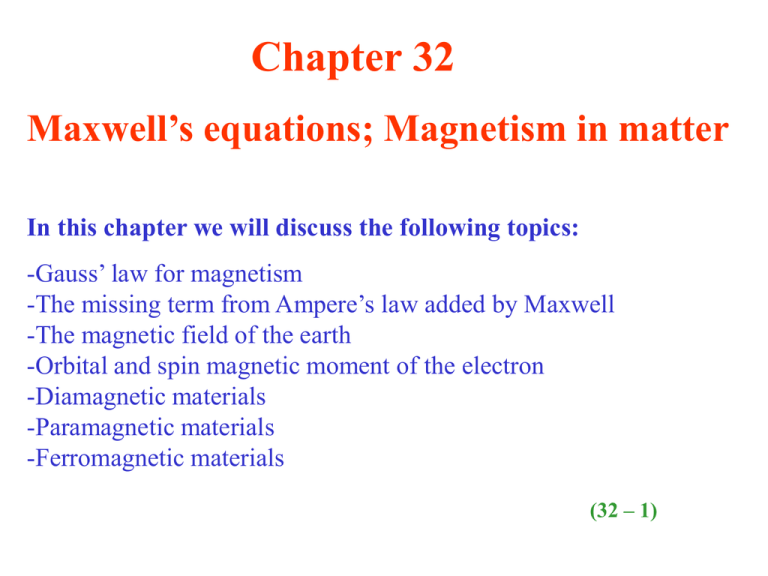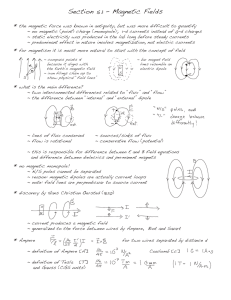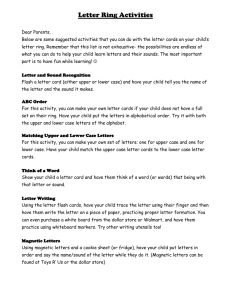Chapter 32 Maxwell’s equations; Magnetism in matter
advertisement

Chapter 32 Maxwell’s equations; Magnetism in matter In this chapter we will discuss the following topics: -Gauss’ law for magnetism -The missing term from Ampere’s law added by Maxwell -The magnetic field of the earth -Orbital and spin magnetic moment of the electron -Diamagnetic materials -Paramagnetic materials -Ferromagnetic materials (32 – 1) The magnetic flux through each of five faces of a die (singular of ''dice'') is given by ΦB = ±N Wb, where N (= 1 to 5) is the number of spots on the face. The flux is positive (outward) for N even and negative (inward) for N odd. What is the flux (in Wb) through the sixth face of the die? A.1 B.2 C.3 D.4 E.5 Gauss' Law for the magnetic field In electrostatics we saw that positive and negative charges can be separated. This is not the case with magnetic poles, as is shown in the figure. In fig.a we have a permanent bar magnet with well defined north and south poles. If we attempt to cut the magnet into pieces as is shown in fig.b we do not get isolated north and south poles. Instead new pole faces appear on the newly cut faces of the pieces and the net result is that we end up with three smaller magnets, each of which is a magnetic dipole i.e. it has a north and a south pole. This result can be expressed as follows: Fig.a Fig.b The simplest magnetic structure that can exist is a magnetic dipole. Magnetic monopoles do not exists as far as we know. (32 – 2) B Bi Magnetic Flux ΦB ΔAi i B dA The magnetic flux through a closed surface is determined as follows: First we divide the surface into n area element with areas A1 , A2 , A3 ,..., An nˆi For each element we calculate the magnetic flux through it: i Bi dAi cos i Here i is the angle between the normal nˆi and the magnetic field Bi vectors at the position of the i-th element. The index i runs from 1 to n n We then form the sum n B dA cos i 1 i i 1 i i i Finally, we take the limit of the sum as n The limit of the sum becomes the integral: B BdA cos B dA SI magnetic flux unit : T m 2 known as the "Weber" (Wb) (32 – 3) B B dA 0 Gauss' law for the magnetic field can be expressed mathematically as follows: For any closed surface B BdA cos B dA 0 Contrast this with Gauss' law for the electric field: qenc E E dA Gauss' law for the magnetic o field expresses the fact that there is no such a thing as a "magnetic charge". The flux of either the electric or the magnetic field through a surface is proportional to the net number of electric or magnetic field lines that either enter or exit the surface. Gauss' law for the magnetic field expresses the fact that the magnetic field lines are closed. The number of magnetic field lines that enter any closed surface is exactly equal to the number of lines that exit the surface. Thus B 0. (32 – 4) Induced magnetic fields dB This law describes dt how a changing magnetic field generates (induces) an electric field. Ampere's law in its original form reads: Faraday's law states that: B dS i o enc E dS . Maxwell using an elegant symmetry argument guessed that a similar term exists in Ampere's law. dE The new term is written in red : B dS oienc o o dt This term, also known as "Maxwell's law of induction" desrcibes how a changing electric field can generate a magnetic field. The electric field between the plates of the capacitor in the figure changes with time t. Thus the electric flux E through the red circle is also changing with t and a non-vanishing magnetic field is predicted by Maxwell's law of induction. Experimentaly it was verified that the predicted magnetic field exists. (32 – 5) B dS oienc o o dE dt The displacement current Ampere's complete law has the form: dE B dS i o enc o o dt dE We define the displacement current id o dt Using id Ampere's law takes the form: B dS i o enc oid ,enc In the example of the figure we can show that id between the capacitor plates is equal to the current i that flows through the wires which charge the capacitor plates. The electric flux through the capacitor plates E AE A The displacement current id o dE 1 q q o i dt o o o q . o o (32 – 6) B dS i o enc oid ,enc Consider the capacitor with circular plates of radius R In the space between the capacitor plates the term i is equal to zero Thus Ampere's law becomes: B dS i o d , enc We will use Ampere's law to determine the magnetic field. The calculation is identical to that of a magnetic field generated by a long wire of radius R. This calculation was carried out in chapter 29 for a point P at a distance r from the wire center. We will repeat the calculation for points outside as well as inside r R the capacitor plates. r R In this example r is the distance of the point P from the capacitor center C. (32 – 7) dS P B r id C R Magnetic field outside the capacitor plates : We choose an Amperian loop that reflects the cylindrical symmetry of the problem. The loop is a circle of radius r that has its center at the capacitor plate center C. The magnetic field is tangent to the loop and has a constant magnitude B. B ds Bds cos 0 B ds 2 rB oid ,enc oid B oid 2 r (32 – 8) Magnetic field inside the capacitor plates We assume that the distribution of id within the cross-section of the capacitor plate is uniform. We choose an Amperian loop is a circle of radius r (r R) that has its center at C. The magnetic field is tangent to the loop and has a constant magnitude B. B ds Bds cos 0 B ds 2 rB i o id ,enc d , enc r2 r2 id id 2 2 R R r2 i 2 rB oid 2 B o d 2 r R 2 R id dS P r C R B o id 2 R O B R r (32 – 9) Maxwell's equations Below we summarize the four equations on which electromagnetic theory is based on. We use here the complete form of Ampere's law as modified by Maxwell: qenc Gauss' law for E : E dA o Gauss' law for B : B dA 0 Faraday's law : E dS dB dt dE dt These equations describe a group of diverse phenomena and devices based on them such as the magnetic compass,electric motors, electric generators, radio, television, radar, x-rays, and all of optical effects. (32 – 10) All these in just four equations! Ampere's law : B dS oienc o o dE A word of explanation : B dS oienc o o dt In this section I will discuss a question which many of you may have. Maxwell added just one term in one out of four equations, and all of a sudden the set is called after him. Why? The reason is that Maxwell manipulated the four equations (with Ampere's law now containing histerm) and he got solutions that described waves that could travel in vacuum with a speed 1 v 3 108 m/s. o o This happens to be the speed of light in vacuum measured a few years earlier by Fizeau. It was natural for Maxwell to contemplate whether light, whose nature was not clear could be such an electromagnetic wave. Maxwell died soon after this and was not able to verify his hypothesis. This task was carried out by Hertz who verified experimentally the existance of electromagnetic waves. (32 – 11) Geographic North (32 – 12) N S Compass needle horizontal Compass needle Fig.b : Side view S Fig.a : Top view The magnetism of earth. Earth has a magnetic field that can be approximated as the field of a very large bar magnet that straddles the center of the planet. The dipole axis does not coincide exactly with the rotation axis but the two axes form an angle of 11.5, as shown in the figure. The direction of the earth's magnetic field at any location is described by two angles: Field declination (see fig.a) is defined as the angle between the geographic north and the horizontal component of the earth's magnetic field. Field inclination (see fig.b) is defined as the angle between the horizontal and the earth's magnetic field. N orb e Lorb 2m Magnetism and electrons There are three ways in which electrons can generate a magnetic field. We have already encountered the first method. Moving electrons constitute a current which according to Ampere's law generates a magnetic field in its vicinity. An electron can also generate a magnetic field because it acts as a magnetic dipole. There are two mechanisms involved. Orbital magnetic dipole moment. An electron in an atom moves around the nucleus as shown in the figure. For simplicity we assume a circular orbit of radius r with e e ev period T . This constitutes an electric current i . The resulting T 2 r / v 2 r evr e mvr e 2 2 ev magnetic dipole moment orb r i r Lorb 2 r 2 2m 2m e In vector form: orb Lorb The negative sign is due to the negative charge 2m of the electron. (32 – 13) S e S m Spin magnetic dipole moment In addition to the orbital angular momentum an electron has what is known as "intrinsic" or "spin" angular momentum S . Spin is a quantum relativistic effect. One can give a simple picture by viewing the electron as a spinning charge sphere. The corresponding magnetic dipole moment is e given by the equation: S S m Spin quantization. Unlike classical mechanics in which the angular momemntum can take any value, spin S and orbital L z-axis Furthermore, we cannot measure the vectors S or L but only B Sz angular momentum can only have certain discreet values. S their projections along an axis (in this case defined by B ). These apparently strange rules result from the fact that at the microscopic level classical mechanics do not apply and we must use quantum mechanics. (32 – 14) e S m S h Sz mS 2 S , z eh 4 m ehB U 4 m z-axis B Sz S (32 – 15) Spin quantization The quantized values of the spin angular momentum are: h mS The constant h 6.63 10 34 J s is 2 known as "Planck's constant". It is the yardstick by which Sz we can tell whether a system is described by classical or by 1 quantum mechanics. The term mS can take the values + 2 1 or . Thus the z-component of S , z can take the values 2 eh S , z . The energy of the electron U S B S , z B 4 m ehB eh U The constant 9.27 10 24 J/T is known as 4 m 4 m the electron "Bohr magneton" (symbol B ). The electron energy U can be expressed as: U B B Magnetic Materials. Materials can be classified on the basis of their magnetic properties into three categories: Diamagnetic, paramagnetic, and ferromagnetic. Below we discuss briefly each catecory. Magnetic materials are characterized by the magnetization vector M defined as the magnetic moment per unit volume. M net A m2 A SI unit for M: 3 m m V Diamagnetism. Diamagnetism occurs in materials composed of atoms that have electrons whose magnetic moments are antiparallel in pairs and thus result in a zero net magnetic moment. When we apply an external magnetic field B, diamagnetic materials acquire a weak magnetic moment which is directed opposite to B. If B is inhomogeneous, the diamagnetic material is repelled from regions of stronger field to regines of weaker B. All materials exhibit diamanetism but in paramagnetic and ferromagnetic materials ths weak diamagnetism is masked by the much stronger paramagnetism or ferromagnetism. (32 – 16) (32 – 17) A model for a diamagnetic material is shown in the figure. Two electrons move on identical orbits of radius r with angular speed o . The electron in the top figure moves in the v+ FB C counterclockwise while that in the lower figure moves in the e F clockwise direction. When the magnetic field B 0 the ω+ magnetic moments for each orbit are antiparallel and thus .B . the net magnetic moment 0. When a magnetic field B is applied, the top electron speeds up while the elecron in the bottom orbit slows down. The corresponding angular speeds C . ω- F e v- FB are: o Be 2m , o Be 2m The magnetic dipole 2 e er moment for the electons is: i r 2 r2 2 2 er 2 er 2 Be er 2 er 2 Be o o 2 2 2m 2 2 2m er 2 net B The negative sign indicates that net are antiparallel 2m F mo2 v+ FB C Top electron : Fnet F FB mo2 evB m2 r Be m r m r eo rB 1 m o e F 2 ω+ .B . F e 2 1/ 2 Be mo o 1 2 o Be Be o 2mo 2m Bottom electron : Fnet F FB mo2 r evB m2 r ωv- (32 – 18) 2 o o 1 C . FB evB eo rB FB Be m2 r mo2 r eo rB 2 o2 1 m o 1/ 2 Be o 1 m o Be Be o 1 o 2 m 2m o Paramagnetism The atoms of paramagnetic materials have a net magnetic dipole moment in the absence of an external magnetic field. This moment is the vector sum of the electron magnetic moments. In the presence of a magnetic field each dipole has energy U B cos . Here is the angle between B and . The potential energy U is minimum when 0. The magnetic field partially aligns the moment of each atom. Thermal motion opposes the alignment. The alignment improves when the temperature is lowered and/or when the magnetic field is large. The resulting magnetization M is parallel to the field B. When a paramagnetic material is placed in an inhomogeneous field it moves in the region where B is stronger. (32 – 18) (32 – 19) Curie's Law M C B T B is below 0.5 the magnetization M of a paramagnetic material T follows Curie's law : B M C The constant C is known as the Curie constant T B When 0.5 Curie's law breaks down and a different approach is required. T For very high magnetic fields and/or low temperatures, all magnetic moments N are parallel to B and the magnetization M sat V N Here the ratio is the number of paramagnetic atoms per unit volume. V When the ratio (32 – 20) Ferromagnetism Feromagnetism is exhibited by Iron, Nickel, Cobalt, Gadolinium, Dysprosium and their alloys. Ferromagnetism is abserved even in the absence of a magnetic field (the familiar permanent magnets). Ferromagnetism disappears when the temperature exceeds the Curie temperature of the material. Above its Curie temperature a ferromagnetic material becomes paramagnetic. Ferromagnetism is due to a quantum effect known as "exchange coupling" which tends to align the magnetic dipole moments of neighboring atoms The magnetization of a ferromagnetic material can be measured using a Rowland ring. The ring consists of two parts. A prinary coil in the from of a toroid which generates the external magnetic field Bo . A secondary coil which measures the total magnetic field B. The amagnetic material forms the core of the torroid. The net field B Bo BM Here BM is the contribution of the ferromagnetic core. BM is proportional to the sample magnetization M (32 – 21) Magnetic domains Below the Curie temperature all magnetic moments in a ferromagnetic material are perfectly aligned. Yet the magnetization is not saturated. The reason is that the ferromagnetic material contains regions "domains". The magnetization is each domain is saturated but the domains are aligned in such a way so as to have at best a small net magnetic moment. In the presence of an external magnetic field Bo two effects are observed: 1. The domains whose magnetization is aligned with Bo grow at the expence of those domains that are not aligned. 2. The magnetization of the non-aligned domains turns and becomes parallel with Bo . Hysteresis If we plot the net field BM as function of the applied field Bo we get the loop shown in the figure known as a "hysteresis" loop. If we start with a unmagnetized ferromagnetic material the curve follows the path from point a to point b, where the magnetization saturates. If we reduce Bo the curve follows the path bc which is different from the original path ab. Furtermore, even when Bo is switched off, we have a non-zero magnetic field. Similar effects are observed if we reverse the direction of Bo . This is the familiar phenomenon of permanent magnetism and forms the basis of magnetic data recording. Hysteresis is due to the fact that the domain reorientation is not totally revesrsible and that the domains do not return completely to their original configuration. (32 – 22)





